Removal Procedure
Caution: Provide additional support when a vehicle is on a hoist:
• Before removing parts, support the opposite end. This helps prevent
the vehicle from slipping off. • Before removing major components, chain the vehicle frame to the
hoist pads at the same end as the removal. This helps avoid a tip-off.
Notice: Do not bend the fuel tank straps as this may damage the straps.
Notice:
• Do not attempt to straighten kinked nylon pipes. Replace any kinked
nylon pipes in order to prevent damage to the vehicle. • Do not attempt to repair sections of nylon pipes. Replace damaged
nylon pipes. • Replace the vapor pipes with original equipment or parts that
meet GM specifications. • Replace the vapor hoses with original equipment or parts meeting
GM specifications. Use only reinforced fuel-resistant hose identified with
the word Fluoroelastomer or GM 6163M on the hose.
Notice: Cap the fittings and plug the holes when servicing the fuel system in order to prevent dirt and other contaminants from entering the open pipes and passages.
Important: Do not attempt to repair sections of nylon fuel pipes. If the nylon fuel pipes are damaged, replace them.
Important: Always maintain cleanliness when servicing fuel system components.
- Relieve the fuel system fuel pressure. Refer to Fuel Pressure Relief .
- Drain the fuel tank. Refer to Fuel Tank Draining .
- Raise the vehicle.
- Loosen the fuel tank filler hose clamp (1) at the fuel tank (3).
- Remove the fuel tank filler hose from the fuel tank.
- Disconnect the quick-connect fittings at the fuel tank. Refer to Metal Collar Quick Connect Fitting Service .
- Disconnect the EVAP pipe from the connection at the front of the fuel tank.
- Remove the rubber exhaust pipe hangers in order to allow the exhaust system to drop slightly.
- With the aid of an assistant, support the fuel tank, and remove the fuel tank strap attaching bolts which retain the fuel tank straps.
- Disconnect the EVAP pipes from the rear of the fuel tank.
- Disconnect the EVAP pipe from the fuel limiter vent valve.
- Disconnect the fuel filler neck EVAP pipe at the rear of the fuel tank.
- Remove the fuel tank from the vehicle and place the fuel tank in a suitable work area.
- If the fuel tank is not being replaced, go to Fuel Tank Installation Procedure.
- Remove the fuel feed, fuel return, and EVAP pipe assemblies and the insulator clips from the fuel tank.
- Remove the fuel limiter vent valve from the fuel tank. Refer to Fill Limiter Vent Valve Replacement .
- Remove the insulator pads from the fuel tank. Note the location of the insulator pads for installation.


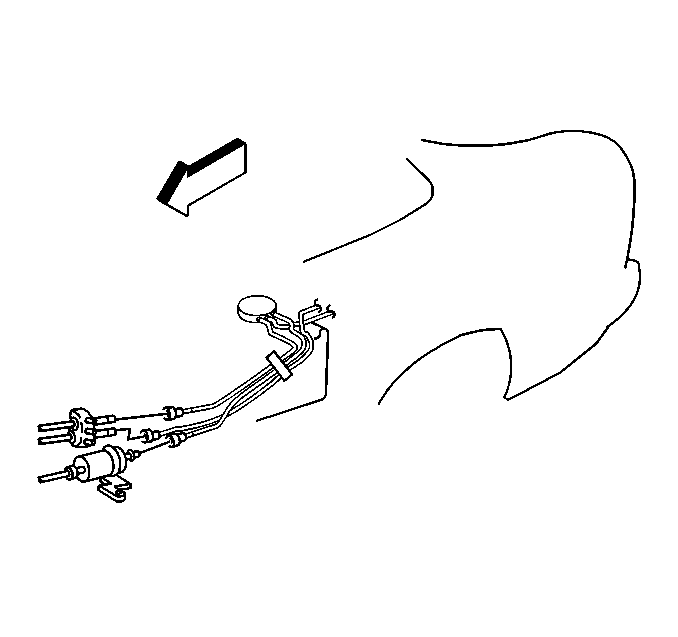
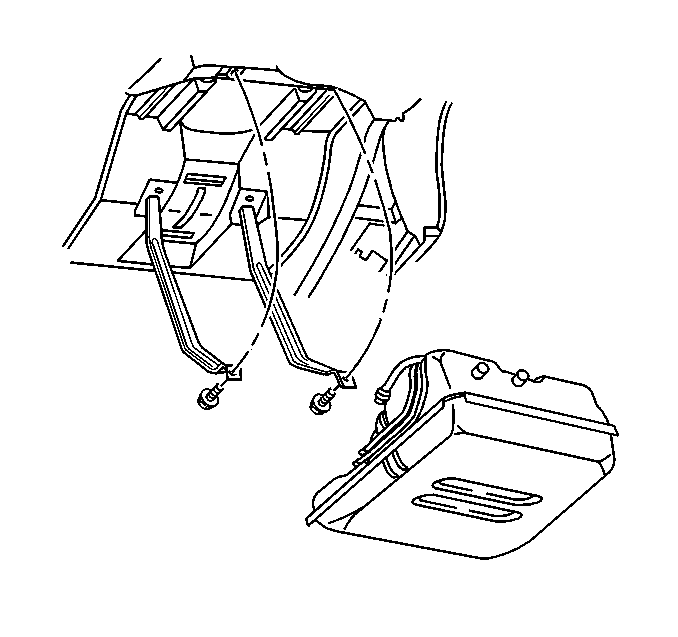
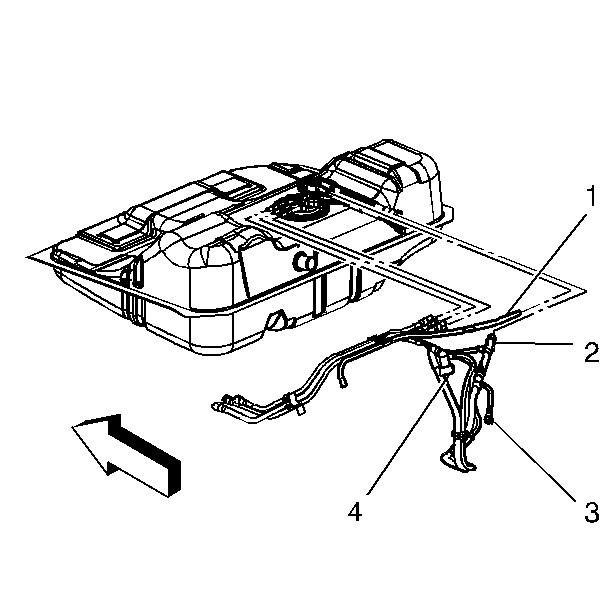
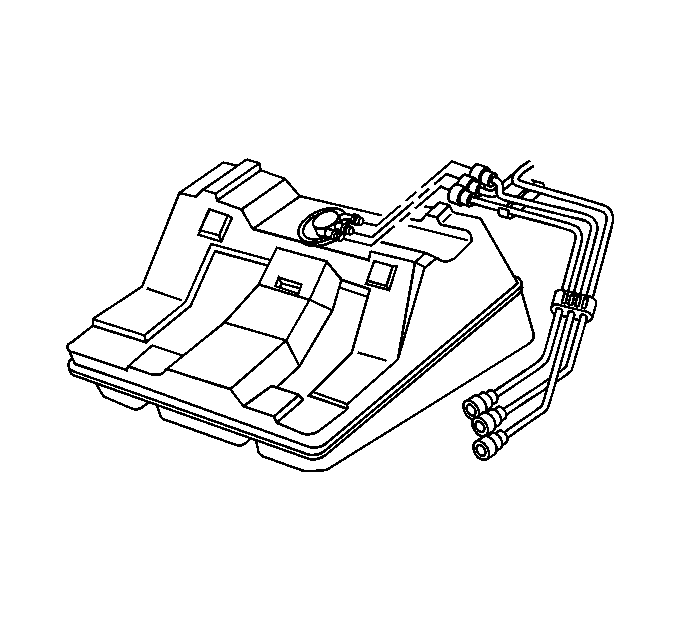
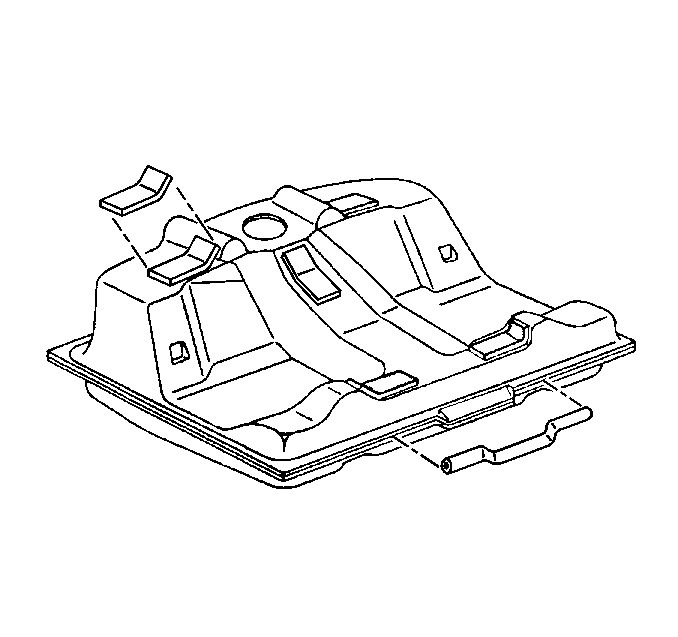
Installation Procedure
- Reinstall the insulator pads on the fuel tank.
- Reinstall the fuel limiter vent valve. Refer to Fill Limiter Vent Valve Replacement .
- Reinstall the fuel feed, fuel return, and EVAP pipe assemblies and the insulator clips.
- With the aid of an assistant, position and support the fuel tank.
- Connect the EVAP pipes to the rear of the fuel tank.
- Connect the EVAP pipe to the fuel limiter vent valve.
- Connect the fuel filler EVAP pipe at the rear of the fuel tank.
- Install the fuel tank retaining strap attaching bolts (2).
- Connect the quick-connect fittings at the fuel tank. Refer to Metal Collar Quick Connect Fitting Service .
- Connect the EVAP pipe at the front of the fuel tank.
- Connect the fuel tank filler hose to the fuel tank.
- Inspect and make sure filler hose (4) is fully seated on fuel tank port (2).
- Make sure clamp (1) is properly located on tank port between the beed (5) and tank (3).
- Reinstall the rubber exhaust pipe hangers.
- Inspect the fuel and EVAP pipes making sure they were not kinked or damaged during removal and installation.
- Lower the vehicle.
- Reinstall the fuel sender assembly. Refer to Fuel Sender Assembly Replacement .
- Add fuel and reinstall the fuel tank filler pipe cap.
- Connect the negative battery cable.
- Inspect for leaks.




Notice: Use the correct fastener in the correct location. Replacement fasteners must be the correct part number for that application. Fasteners requiring replacement or fasteners requiring the use of thread locking compound or sealant are identified in the service procedure. Do not use paints, lubricants, or corrosion inhibitors on fasteners or fastener joint surfaces unless specified. These coatings affect fastener torque and joint clamping force and may damage the fastener. Use the correct tightening sequence and specifications when installing fasteners in order to avoid damage to parts and systems.
Tighten
Tighten the front fuel tank retaining strap bolts (2) to 48 N·m
(35 lb ft).



Tighten
Tighten the fuel tank filler pipe hose clamp to 2.5 N·m
(22 lb in).
Caution: Unless directed otherwise, the ignition and start switch must be in the OFF or LOCK position, and all electrical loads must be OFF before servicing any electrical component. Disconnect the negative battery cable to prevent an electrical spark should a tool or equipment come in contact with an exposed electrical terminal. Failure to follow these precautions may result in personal injury and/or damage to the vehicle or its components.
| 20.1. | Turn the ignition switch ON for 2 seconds. |
| 20.2. | Turn the ignition switch OFF for 10 seconds. |
| 20.3. | Turn the ignition switch ON. |
| 20.4. | Check fuel leaks. |
